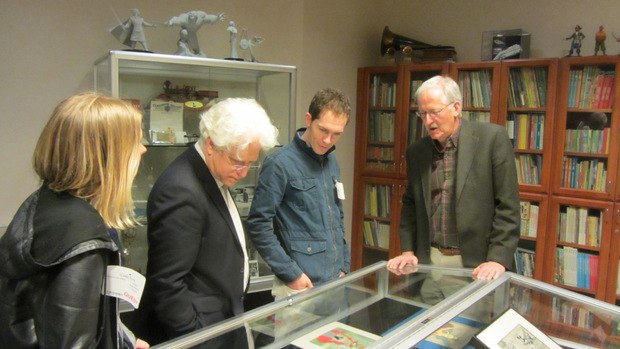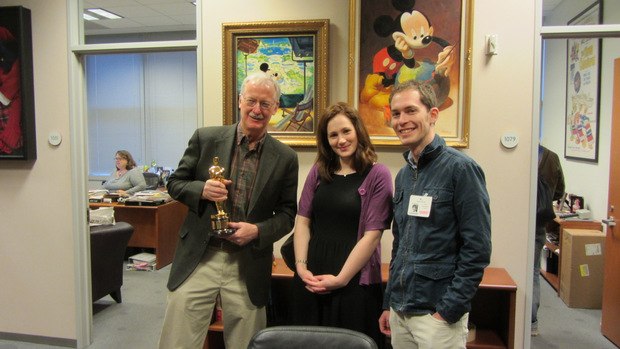Day 2 in Los Angeles continues at Disney Feature Animation, highlighted by a studio tour with John Musker.
By Dan Sarto
With a full afternoon planned at Disney Feature Animation, the group wasted no time getting started. Our host, Stephanie Morse, toured us through the maze of halls, with stops every now and again to check out walls adorned with artwork from Frozen, their upcoming feature set for release this coming November 27th. Soon, however, it was back to the screening room for audience Q&A.
Once again, our filmmakers displayed great patience as they answered mostly the same set of questions they’ve been answering at numerous screenings, interviews and meetings ever since they were nominated. I enjoy these Q&A sessions because though the questions may be the same, each time a filmmaker speaks, they add something new, share greater details or a new story you haven’t heard before. You never know what tasty tidbits they may share in a moment of fatigue.
Some of the Q&A highlights:
Question: None of the films featured any dialogue. I’m curious how that decision came to be in each of your films and why that was important?
John Kahrs: We get this question a lot, as a group. Visual storytelling is a fun challenge. It’s almost more satisfying for the audience to have to work. The work the audience has to process, to determine how something could have happened, those are like yummy filmmaking events. Dialogue is a whole other world and actually, I don’t think I’m ready for it [laughter].
Minkyu Lee: My story is about a dog and a man, so of course, there’s not going to be real dialogue [laughter].
Tim Reckart: With Head Over Heels, we definitely knew that it should be dialogue free because the whole thing was a metaphor…did you guys get that? [laughter] We were already using that metaphorical, poetic language so it seemed like it would be a betrayal of the whole concept to start having these characters talk.
Question: Can you talk about any big challenges you faced on your productions?
Fondhla Cronin O’Reilly: It took us quite a while to convince our teachers to allow us to make this film because they didn’t think we could actually make it. First we did an animatic. We also did a photomatic. We shot with our DP and Tim to make sure they were translating the story properly.
TR: A photomatic is not standard. We built a mockup and shot the animatic again so we could experiment, have a bit of that stop-motion thing of being able to put the camera on the set. Figuring out the storytelling was the challenge.
David Silverman: We started to board in 2011 from March until June. I built the animatic story reel mostly by myself. But, it didn’t quite work. Actually about half of it is in the final film. But then it sat on the shelf for nine months. Then we gave it another shot. Once we got the OK, it went very fast. I guess the challenge was the production period suddenly became, “OK, that four month production schedule…you now have two because it has to be in front of Ice Age!” OK! The other challenge was the 3D aspect. We had experimented with existing animation but we hadn’t done it where every scene had to be broken down in cleanup. Maggie’s bow, or her pacifier, her eyes and nose, her outline, basically everything was broken into different levels so we could do the 3D with it. That actually worked out faster than I could ever imagine.
JK: For Paperman, the challenge was having an idea of what you want to see, of having a drawing move out there in space, in a way you haven’t really seen before, and not having the tools yet to achieve what we did. At the beginning of the show, it was like, “We don’t even know how we’re going to do this and why would you even want to be associated with that short film? That sounds like a nightmare.” [laughter]
ML: This is always a tough question for me because every aspect of the film was a challenge. A big one was working with no budget and no producer. Working on this film definitely made me come to a huge appreciation for producers…shout out to producers [laughter] who have probably all gone because they have to work on their films. I thought I could be the director and producer at the same time. But I came to learn those two roles are played by two different people for very specific reasons. It was also tough completing the film with all volunteers. There were aspects of the film I had never done before, like painting backgrounds or putting stuff together in After Effects and Premier. Sound, I just jumped in without knowing what to expect. I had to learn all those things one step at a time.
With the Q&A complete, it was time for lunch. As it had begun raining outside, we shifted plans and ate inside rather than on the terrace. We were joined by a number of key Disney artists and producers including Eric Goldberg, Mike Gabriel and Osnat Shurer, who used to head Pixar’s shorts group and is now doing feature film development.
With the group now watered and fed, the tour continued. We met up with Lino DiSalvo, supervising animator on Frozen, who walked us by numerous pieces of concept and character design artwork, describing some of the decision-making and creative iterations that went into the final work. In a space right outside Glen Keane’s old office, we sat and watched a series of animation tests, including a segment involving design and movement studies for Olaf, a goofy looking snowman voiced by Josh Gad. Unfortunately, we weren't allowed to take any pictures on this entire leg of the tour.
From there, we were met by none other than John Musker, a studio and industry legend who with his writing partner Ron Clements wrote and directed such Disney films as Little Mermaid, Aladdin, Hercules and The Princess and the Frog. Though a few years their senior, as many of his classmates had started right out of High School, John had gone to CalArts with John Lasseter, Brad Bird, Tim Burton, Henry Selick and Chris Buck (among others). We spent the next hour or more with John, walking all over the Disney lot across Riverside Drive from the Roy E. Disney Animation Building. Having worked at Disney since 1977, his knowledge of the company, the shows, the people, not just from a historian’s perspective but from the view of someone smack dab in the middle of the action, was truly mesmerizing.
We talked about the Zorro parking structure, built on top of the set of the late 1950s TV show Zorro, starring Guy Williams, who later starred in Lost in Space. It turns out that for the third Pirates of the Caribbean movie, the production mounted a giant pirate ship on top of the Zorro parking structure to enable needed low angle shots. Ron and I joked that was probably the second biggest pirate ship on a parking structure people had ever seen (ongoing Get Smart joke that no one gets but we still think is hilarious).
We continued snaking through the lot, peering into sound stages that once housed Tim Allen’s Home Improvement and now house Body of Evidence. As we walked by the old animation buildings, John pointed out the window he broke one day playing Frisbee. He brought us to a recording studio, now being used on ABC’s Once Upon A Time, that he had used to record the voice actors on Little Mermaid.
He walked us through the halls of the old feature animation building, rich in Disney history, long since vacated and taken over by various live action production units. He pointed out his old office down one hall, where Milt Kahl had his office down another, where Frank and Ollie had offices while still animating before moving up to the second floor when they started writing The Illusion of Life. He shared a hilarious story about Tim Burton, who came back to the studio after having had his wisdom teeth removed, drooling blood for dramatic effect, walking through the office like a zombie.
Eventually we made our way over to the Disney Legends Plaza. There he showed us Randy Newman’s plaque, and told the story of how Randy, upon signing his cement handprint, worried he might run out of room. So, he enlisted John Lasseter to help him write the last three letters of his last name. The joke, he quipped, is that Lasseter helped put the “man” in Newman.
We made stops at the archive and multi-plane camera within the Frank G. Wells building before heading back over to feature animation to conclude our tour. Time spent at Disney is unlike any other stop on the tour, wonderful as they all are. The company’s heritage is an omnipresent, though often subtle partner is everything animation. This rich history brings contextual nuance and meaning at every level that is unique among the studios. You feel the gentle warmth everywhere, particularly in the eyes and within the smiles of the artists you meet. It’s really something special.
Next stop – the Motion Picture Academy for a night of shorts.
Dan Sarto is Publisher and Editor-in-Chief of Animation World Network.

















